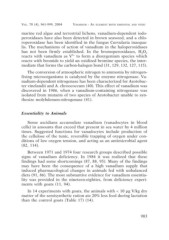Page 199 - 70_04
P. 199
VOL. 70 (4), 961-999, 2004 VANADIUM - AN ELEMENT BOTH ESSENTIAL AND TOXIC
marine red algae and terrestrial lichens, vanadium-dependent iodo-
peroxidases have also been detected in brown seaweed, and a chlo-
roperoxidase has been identified in the fungus Curvularia inaequa-
lis. The mechanisms of action of vanadium in the haloperoxidases
has not been firmly established. In the bromoperoxidases, H2O2
reacts with vanadium as V5+ to form a dioxygenium species which
reacts with bromide to yield an oxidized bromine species, the inter-
mediate that forms the carbon-halogen bond (31, 129, 132, 127, 115).
The conversion of atmospheric nitrogen to ammonia by nitrogen-
fixing microorganisms is catalyzed by the enzyme nitrogenase. Va-
nadium-dependent nitrogenase has been characterized for Azotobac-
ter vinelandii and A. chroococcum (40). This effect of vanadium was
discovered in 1986, when a vanadium-containing nitrogenase was
isolated from mutants of two species of Azotobacter unable to syn-
thesize molybdenum-nitrogenase (41).
Essentiality to Animals
Some ascidians accumulate vanadium (vanadocytes in blood
cells) in amounts that exceed that present in sea water by 4 million
times. Suggested functions for vanadocytes include production of
the cellulose of the tunic, reversible trapping of oxygen under con-
ditions of low oxygen tension, and acting as an antimicrobial agent
(82, 114).
Between 1971 and 1974 four research groups described possible
signs of vanadium deficiency. In 1984 it was realized that these
findings had some shortcomings (87, 88, 95). Many of the findings
may have been the consequence of a high vanadium supply that
induced pharmacological changes in animals fed with unbalanced
diets (91, 86). The most substantive evidence for vanadium essentia-
lity was provided in the nineteen-eighties, from deficiency experi-
ments with goats (11, 94).
In 14 experiments with goats, the animals with < 10 µg V/kg dry
matter of the semisynthetic ration ate 20% less feed during lactation
than the control goats (Table 17) (14).
983

